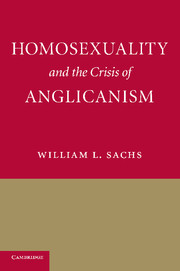Book contents
- Frontmatter
- Contents
- Acknowledgements
- 1 A definitive moment
- 2 The shape of early Christian unity
- 3 When ideals encounter realities
- 4 Reform and the power of the periphery
- 5 Anglican tradition and local prerogative
- 6 The triumph of indigenous Anglicanism
- 7 The rise of Liberalism
- 8 In search of the pure church
- 9 Beyond warring parties?
- Index
- References
2 - The shape of early Christian unity
Published online by Cambridge University Press: 05 June 2012
- Frontmatter
- Contents
- Acknowledgements
- 1 A definitive moment
- 2 The shape of early Christian unity
- 3 When ideals encounter realities
- 4 Reform and the power of the periphery
- 5 Anglican tradition and local prerogative
- 6 The triumph of indigenous Anglicanism
- 7 The rise of Liberalism
- 8 In search of the pure church
- 9 Beyond warring parties?
- Index
- References
Summary
THE MEANS OF SOCIAL INTEGRATION
In proposing a way to resolve culture wars, Jeffrey Stout explores what holds modern democratic societies together and what threatens to divide them. He probes the sources of traditionalist discontent and notes that traditionalists are united by a suspicion that modern democracies devalue historic forms of belief and practice while claiming to adjudicate equitably among competing truth claims in pluralistic circumstances. Instead traditionalists seek a fixed way of life grounded in a certainty that only tradition of one sort or another can guarantee. They argue that Liberalism offers false reliance on reason that promises a universally valid outlook it fails to deliver. Stout accepts this view when he notes that the Liberalism of John Rawls proposes a theory of justice grounded in individual and group rights. This approach exacerbates the problem of finding a universal standpoint rather than resolving it. But in Stout's view Traditionalism also falls short. The stance of a leading traditionalist, Stanley Hauerwas, illustrates the problem. Hauerwas argues not for a comprehensive view of social whole as Stout would like, but for the church as a community distinct from the rest of society. His position appears susceptible to the trap that ensnared Rawls because Hauerwas privileges one social form rather than suggesting how divides might be overcome. His view reveals the logic by which traditionalists would withdraw from larger social worlds: persuaded that society was dismissive of their sentiments and could not be redeemed traditionalists might create their own enclave within which their ideals of belief and practice could be rigorously enforced.
- Type
- Chapter
- Information
- Homosexuality and the Crisis of Anglicanism , pp. 29 - 60Publisher: Cambridge University PressPrint publication year: 2009



